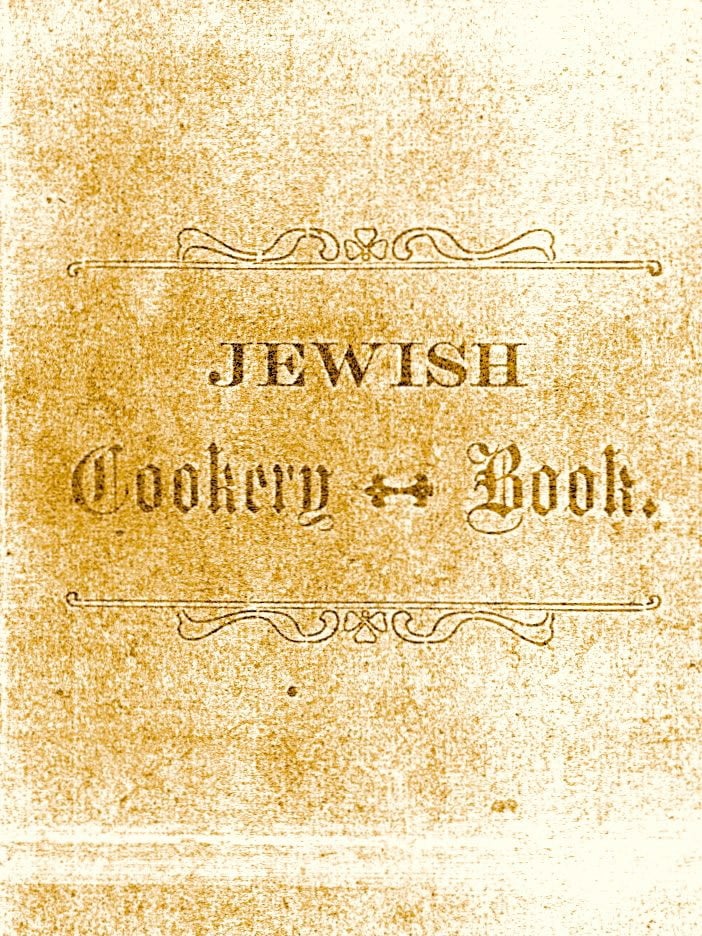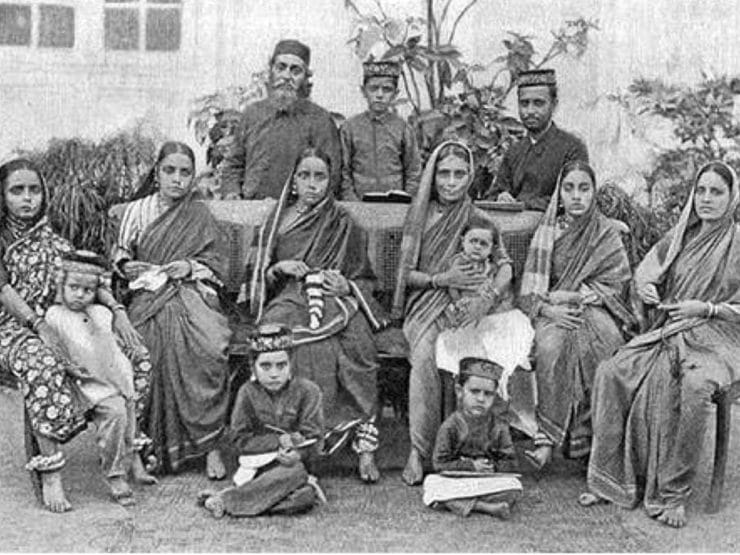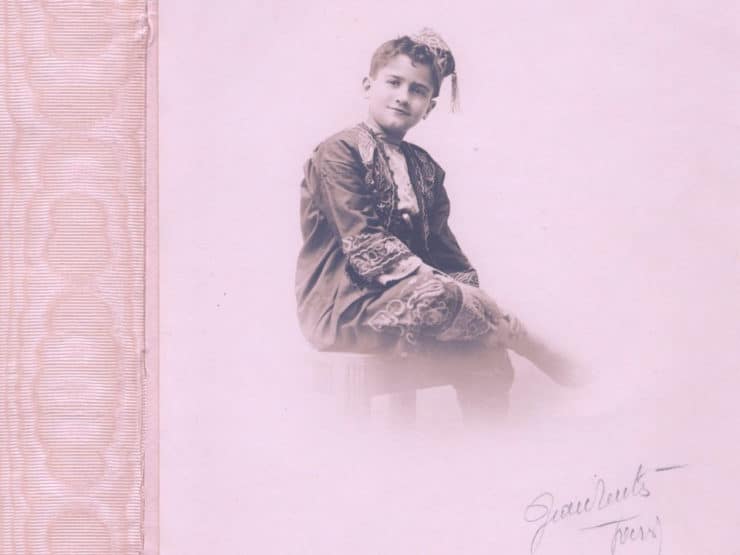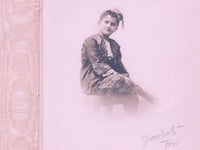
A few months ago, blog reader Barry Scott wrote me an intriguing email:
Dear Tori,
I thought that you might be interested in this cookbook. It was published in 1922 in Calcutta, India. My father-in-law, a Jew of Calcutta, gave a copy of this book to me. The Jews of Calcutta had a long and colorful history. They settled there well over two hundred years ago…
Barry scanned a copy of the book, entitled the Jewish Cookery Book, and sent it to me. It was published by Mrs. H. Brooke and printed by East Bengal Press, 52/9 Bowbazar Street, Calcutta. I have a pretty large collection of vintage cookbooks (both Jewish and non-Jewish), but this volume was totally new to me. It contains several kosher Jewish Indian recipes, including some I’ve never heard of before.
This seemed like the perfect opportunity to take a deeper look at Jewish Indian cuisine. I pored over the scanned pages of the cookbook, taking in all of the dishes, exotic spices, and ingredients. Some of the recipes were familiar to me, others completely new. I chose a dish that sounded tempting and went for it!
Before I started cooking, I did some research on the history of Indian Jewry. Rather than one mass migration, Jewish groups have settled in India at different times throughout the centuries. India’s Jews descend from four major groups—the Cochin, the Bene Israel, the Paradesi, and Baghdadi. The Bene Israel and the Cochin Jews claim to be descendants of the ten lost tribes of Israel.

Cochin Jews, circa 1900. Jewish Encyclopedia, 1901-1906
The Cochin Jews are the most ancient group of Jews in India. They claim roots in India from the time of King Solomon, though it can only be historically verified that they resided in India after 70 CE. After the Second Temple in Jerusalem was destroyed, a wave of settlers landed in the ancient port of Cranganore. They moved to nearby Cochin in the late fifteenth century after the Portuguese invaded, and were welcomed there by the maharajah. An area called Jew Town was established, where the Cochin Jews lived in harmony with their Hindu neighbors. They became involved in trading pepper, cinnamon, nutmeg, ginger, and other spices.
In the 16th century, Sephardic Jews were exiled from the Iberian Peninsula. A group of these Sephardim settled in Cochin. Known as Paradesi Jews, this group had lighter skin than the original Jewish settlers of Cochin (known as Malabari Jews). The customs of the Malabari were quite different from the Paradesi, and tension developed between the two populations. A division soon emerged; black Malabari Jews were often treated with disdain. They were barred from attending the white Paradesi Synagogue, and the Paradesi looked down upon the Malabari in business and trade dealings. Despite the issues between the Malabari and the Paradesi, the Cochin lived relatively peacefully in India for centuries.

Bene Israel Family at Bombay, circa 1900. Jewish Encyclopedia, 1901-1906
The Bene Israel Jews believe that their ancestors were oil pressers in the Galilee, who fled by sea to escape religious persecution in the 2nd century B.C.E. Legend says that seven Jewish couples survived a shipwreck on the Konkan Coast of India, on the shores of Kolaba; those seven couples are said to be the ancestors of modern day Bene Israel Jews. The shipwrecked Jews washed up near a village called Navgaon; all of their belongings were lost at sea. The survivors settled in Navgaon and started working in agriculture and oil pressing. Over the centuries, the descendants of the Bene Israel continued to carry on key Jewish traditions, including keeping kosher, circumcision, and observing Shabbat. The small group of Jews was “rediscovered” in the 18th century by traders from Baghdad, Iraq.
While the shipwreck story has at times been questioned over the years, the Bene Israel may, in fact, be right about their ancestry. According to a research study published in the early 90’s by Tudor Parfitt at London’s School of Oriental and African Studies, which gathered DNA from over 4,000 case studies, the Bene Israel are likely descendents of the Israelite Kohanim tribe.

Barry’s father-in-law, Ezra Joseph Gubbay, a Jew of Calcutta – 1930
More recently, a wave of Baghdadi Jews settled in India. Not all Baghdadi Jews are from Iraq; the Baghdadi name is also used to encompass immigrants from Iran, Yemen, and Afghanistan. Around 250 years ago, a wave of Jews emigrated from these countries to India, settling in Surat and later Bombay and Calcutta (now known as Kolkata). Baghdadi Jews established a trading network from Syria and Baghdad and Bombay to Calcutta, stretching all the way to Japan and Hong Kong. They quickly found success in trading, and the community thrived. Many Baghdadi Jews made their home in Calcutta, where Barry Scott’s father-in-law Ezra Joseph Gubbay lived—and where the Jewish Cookery Book was written. Ezra, like many Baghdadi Jews, was involved in various trading that included indigo, textiles, and precious stones.
Sadly, the population of Jews in India is now dwindling. After World War II, the rise of Indian nationalism made things tense for Jews in India, who were closely associated with Great Britain. The Jews began leaving in the 1940’s, emmigrating from India to Israel, the U.S. and England. A few elderly Jews stayed behind, but that population is slowly disappearing. In Calcutta, a once thriving community of 5,000 Jews is now on the verge of extinction.
The Jews may have left India, but their culinary traditions live on. Like other Jewish communities around the globe, Indian Jews have adapted the regional cuisine of their adopted country to make it kosher. The unique spices of the region are used freely in Indian Jewish recipes, as are regional kosher substitutes (like using coconut milk as a pareve alternative to milk or cream). Lamb (referred to in the cookbook as “mutton”) is used instead of beef as a red meat source; this is because the Hindus have a sacred respect for cows, and the Indian Jews generally respected this restriction. By exploring these recipes today and savoring these very special Indian flavors, we can imagine what it was like to live a Jewish life in India.
In my next blog, I’ll dig deeper into Ezra Joseph Gubbay’s family story. I’ll also share a recipe from the vintage Jewish Cookery Book from Calcutta. Stay tuned!
Update: I’ve posted the Gubbay family story and a recipe from this cookbook. Click here to view.



I was born in Calcutta, lived abroad, in Israel and U.S.A and have now returned to live here in Calcutta. .Had a Kosher Indian restaurant in jerusalem called the Maharajah My book “Around the world with a skillet”has many Indian jewish recipes, though it is now out of print.I am about to publish another book on International cooking, called 3 cups of Flower ,,which will have compete chapters on Jewish , Middle eastern, Far eastern and Indian Cooking Other books include a chapter on Indian cooking in the International Kosher Cookbook, from the 92nd st Y. Mutton in old books usually refer to goat, which was slaughtered Kosher only rarely during High Holidays Copeland Marks, and Mavis Hyman have both written good books on Jewish cooking in India and there is also a book called “Awafi” published by Baghdadi Jews in Sydney, Australia
My family was from Calcutta, but sadly I don’t have anybody to ask about recipes anymore. Where can I get a copy of this book please?
the elephant house (now the giraffe enclosure) at calcutta zoo is still called ‘gubbay house’ he he he
I would like to meet with the existing Jewish community in Kolkata. Whom can I get in touch with?
I am reachable at amberdey@gmail.com or on 9836760813
Would love to hear from someone!
I am an Indian I love cookbooks …you are lucky to find such an oldindian cookbook you do not find many old Indian books you are lucky to find one…
Keep us updated on your new finds
I am also an Indian Jew from Calcutta, I was 12 when I left for the UK and now I live in Los Angeles, California, USA. I have a few books on our cooking, and yes I do cook.
Have you heard of Copeland Marks? His book on the varied Kitchens in India has all different types of cooking including ?Anglo Indian and Jewish cooking from the Middle East, where our food originated.
loved reading about the Calcutta Jewish community.I myself grew up in Calcutta 1951 _68 and we had lots of Jewish friend,_ I remember the Morris family especially!!!
Hi. I am one of those Morrises descendants!
the jewish boy in the bottom photo clothes, is the designs on it similar to the designs they had on their clothing before they were kicked out of Spain in the 1500’s? if so amazing traditional clothes
It should be kept in mind that “mutton” in India refers to both lamb and goat meat, the latter being more freely used and available. Thanks for a very nice post.
A review of Nathan Katz’s comprehensive book on Jews of India and my own experience at the Pardesi Synagogue in Kochi.
http://accidentalblogger.typepad.com/accidental_blogger/2006/03/a_distant_land_.html
http://accidentalblogger.typepad.com/accidental_blogger/2008/11/a-pardesi-life.html
Mordecai Cohen, I am afraid you are somewhat mistaken, at lest as far as terminology in the United States.
Mutton is the meat of an adult sheep, while lamb is the meat of a young (up to a year old) sheep.
The meat of an adult goat is called either chevon or goat, and the meat of a young goat (or kid) is called cabrito.
The colloquial use of the term “mutton” for goat meat is largely confined to a few countries in Asia.
I have had all four varieties. With proper preparation, they are all delicious.
Your readers will find this site interesting:
http://jewsofcochin.blogspot.com
Hi Tanya,
There is a cookbook called Sephardic Cooking by Copeland Marks and there is a section on Cochini Jewish cooking.
Would love to know the recipes from Cochinii Jews, how can I get them..
love indian food and we have many good indian
restruants here in los angeles.
the meat from the goat is mutton and from the sheep
is lamb.very few places sell mutton in this city ,there r
some from Bungler Desh who sell it most prepare lamb.
Melanie, we greatly enjoy Indian cooking, and I appreciate your recommendation for those three Indian Jewish cookbooks. I have several Indian cookbooks, but it’s hard to adapt some of the recipes for kosher cooking. And I’d like to learn more about Indian-Jewish cooking as opposed to the dishes served in most Indian restaurants in the U.S. So I’m going to start with the one by Mavis Hyman. Are the others also for Jewish-Indian cooking or just Indian cooking? Also, do you have any recommendations for books to read about the Indian-Jewish community? A Jewish student at the university here in town is an American-born son of a family from Cochin, but sadly, he knows little of his heritage. Thanks again for your post! And, of course, thanks to Tori for providing the space for these conversations…and great recipes.
I am a Jew from Calcutta and now live in Los Angeles. There are several books on Indian Jewish cooking. One is called, Indian-Jewish Cooking by Mavis Hyman. Another is, The Varied Kitchens of India by Copeland Marks. Still another is, Around the World with a Skillet by Flower Silliman. They are all good.
My great (to the 4th power) grandfather started the Jewish community in Calcutta, two hundred and fifty years ago. You can Google Bagdadhi Jews from Calcutta if you are interested. There were Jews in Singapore too. My mother was born there and her mother was born there also. Their families came from the Middle East originally. Their cuisine is also fabulous. It incorporates Malay, Indonesian, Indian, and Chinese cuisines into their Middle Eastern recipes. Such great food, we must keep these recipes alive because these cultures will be lost with the last of our generation. I am very happy to see there is interest in our cuisine and culture.
Hi Melanie,
Nice to see you here and to read your comments – so true about Indian Jewish cooking, though I would like to add that when we talk about the Baghdadi Indian cooking, it is very very similar to the Iraqi Jewish food, only after coming to Israel and mixing with the Iraqi origins here I discovered that many of our dishes are so similar – again as with us Jews so easily adapting to our surroundings whereever we go. May I recommend to those people looking to learn about their heritage (Indian heritage) to visit our website – http://www.indianjews.org/english/ – it is a new Indian heritage center started in Israel by volunteers working to save our heritage which unfortunately is disappearing with the new generation. This center needs the help of each and every one financially and emotionally – and with information lots of information – so anyone reading this and interested in helping in this project please do contact me, lets save the Indian heritage and pass it on to the next generation.
As one of the handful of Jews still living in Calcutta, I find all this very interesting. Yes, to clarify – “mutton” is goat’s meat, though I believe sheep are occasionally slaughtered at Bakr’Eid.
We haven’t had a shochet here for years, so the few old folk who still keep kosher eat fish, eggs and veg. When I visit my children in Israel I bring back Osem chicken soup for two old ladies who are friends of mine. Israeli supermarkets are like Aladdin’s cave with their treasure trove of kosher products !
I am descended from your family. Bella Duek Cohen was my great grand mother.
My mother was a Jew. Her father, my grandfather was Aaron Joseph Hyam. My grandmother was Rosy Hyam. My cousins have all left Kolkata a long time back and some have settled in UK and USA.
I really miss my mother’s Jewish cooking. I never learnt to cook them when she was alive. And now there is no one to make it like her. 🙁
An Indian restaurateur acquaintance told me about an intriguing dish called Cochin chicken, which is baked in clay and started before the beginning of Shabbat. Thanks for the great post; that cookbook is really interesting!
Absolutely fascinating!
Who wouldn’t want those recipes, if they love cooking? I look forward to them and wonder if you’ll print them on your site.
What a fascinating blog, as a Sephardic Mexican Jew living in the US, I think it’s incredible that they have been able to maintain and keep kosher after so many years.
Very interesting, I would love to read more.
thanks